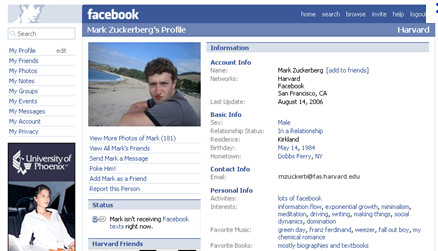Almost no one attended Mark Zuckerberg’s 2005 lecture at Harvard University. Facebook was one year into its growth, having expanded into 2,000 schools and generating 400 million page views per day. How times have changed.
The social network’s school-by-school outreach approach quickly proved to be a successful business strategy that eventually invited public registration in 2006 (here’s a very old TechCrunch article covering the news). I remember it well; 16 years old and relieved that I didn’t have to wait two years before joining University to claim membership.
The global web statistics for Facebook today are staggering:
- 936 million daily active users on average for March 2015
- 798 million mobile daily active users on average for March 2015
- 44 billion monthly active users as of March 31, 2015
- 25 billion mobile monthly active users as of March 31, 2015
- Approximately 82.8% of daily active users are outside the US and Canada
If you think these results are generated by a B2C audience of mostly students, think again. Last year US reports highlighted a 25% drop in 13-17 year-olds being active on the site, replaced by an 80% increase in the 55+ age group. It’s widely accepted that the same trend is being experienced in the UK.
The evolving demographic plays to Facebook’s favour as alternative methods of using the site are discovered. Whilst Facebook is not typically deemed a ‘professional’ social network, Greenwich Associates in 2014 revealed 78% of institutional investors in Asia Pacific said Facebook was used at least once a month to source financial information. Furthermore, a third of asset owners made an investment decision or recommendation based on social media output; 85% of which relied on social content from LinkedIn (a professional network).
Facebook has a growing value for financial services but companies first need to understand how to best utilise and engage the right audiences.
How financial services should engage Facebook audiences
The Facebook 2015 Industry Report by Simply Measured analysed 11,522 posts by 96 brands, measuring the engagement of 1,172,091,468 fans; it’s clear to see that financial services companies are still trying to find their feet in the digital environment.
Findings revealed:
- Financial services brands posted 2% less in Q1 2015 than in Q4 2014, including 17% more links, 13% fewer photos, 100% more statuses, and 9% fewer videos
- Financial services brands’ link posts received 28% more engagement in Q1 2015 than in Q4 2014
- Financial services brands received 15,920 comments in Q1 2015, 19% fewer than they received in Q4 2014
- Financial services brands received 586,105 Likes in Q1 2015, 20% fewer than they received in Q4 2014
- Financial services brands received 45,111 shares in Q1 2015, 55% fewer shares than they received in Q4 2014
- Financial services brands decreased 24% in total engagement, coming in at 648,136 in total engagement
The findings highlighted that the majority of financial services companies are struggling to create content that captivates their audiences. Primarily due to the lack of videos and images used to tell stories. Other brands in the report (including consumer facing) received the greatest share of growth and voice on Facebook by using photos and images, indicating that Facebook users interact with these posts most frequently.
Therefore, creating more visual content presents financial services companies with an opportunity to beat their competitors in stimulating engagement and driving fan numbers on Facebook. Keeping this in mind, here are three takeaways for financial services companies on Facebook:
- Have a clear strategy in place to use Facebook as part of a wider digital strategy. Set clear objectives for the network and the desired business outcomes expected;
- Spend time investing in high-quality image and video content that captures the attention of your Facebook page. These will drive more engagement on average than text only updates;
- Support Facebook page activities with advertising campaigns that increase the reach of your social updates and drives fan numbers. Organic reach is declining due to increased competition among companies (official advice here).





